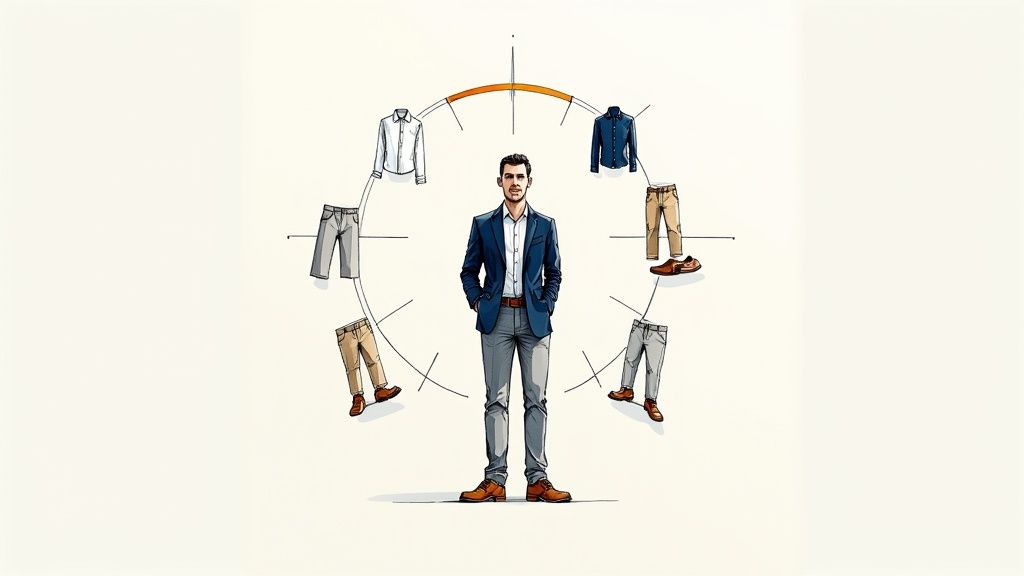
Business Casual Dress Code Men: The Essential Guide
By Emma Johnson - 9/25/2025
Staring into your closet, completely baffled by the term 'business casual'? You're definitely not alone. It's one of the most confusing dress codes out there, sitting somewhere in the murky middle ground between a full suit and your favorite weekend jeans.
So, what is it really? Think of business casual as professional, but with a more relaxed personality. It’s about ditching the rigid suit and tie for more versatile, comfortable pieces like chinos, sharp button-down shirts, and smart loafers.
Decoding Today's Business Casual Dress Code
The term itself feels like a contradiction, and its definition has become a moving target in the modern workplace. It first popped up back in the '80s and '90s as companies looked to create a more comfortable office vibe, but today, it's more flexible than ever.
The best way to approach business casual isn't as a strict uniform, but as a way to communicate competence and approachability. You want to look sharp and put-together without coming across as overly formal or unapproachable. The secret is understanding that business casual lives on a spectrum.
The Style Dial Concept
I like to think of it as a "style dial." You can turn it up or down depending on the day.
Got a big client presentation? Turn that dial up towards 'business' with a sport coat, a crisp dress shirt, and some well-fitting wool trousers. For a regular day of internal meetings, you can turn it down towards 'casual' with a pair of classic chinos and a high-quality polo shirt.
A few things will help you figure out where to set your dial:
- Your Industry: A tech startup’s version of business casual is going to be worlds away from a law firm’s.
- Company Culture: This is huge. Take a look at what your boss and senior colleagues are wearing. That's your best clue to the unwritten rules.
- Your Daily Schedule: Your outfit should match your agenda. If you're meeting clients, dress up. If you're chained to your desk, you can afford to be a bit more relaxed.
To give you a quick visual, here’s a breakdown of the core pieces.
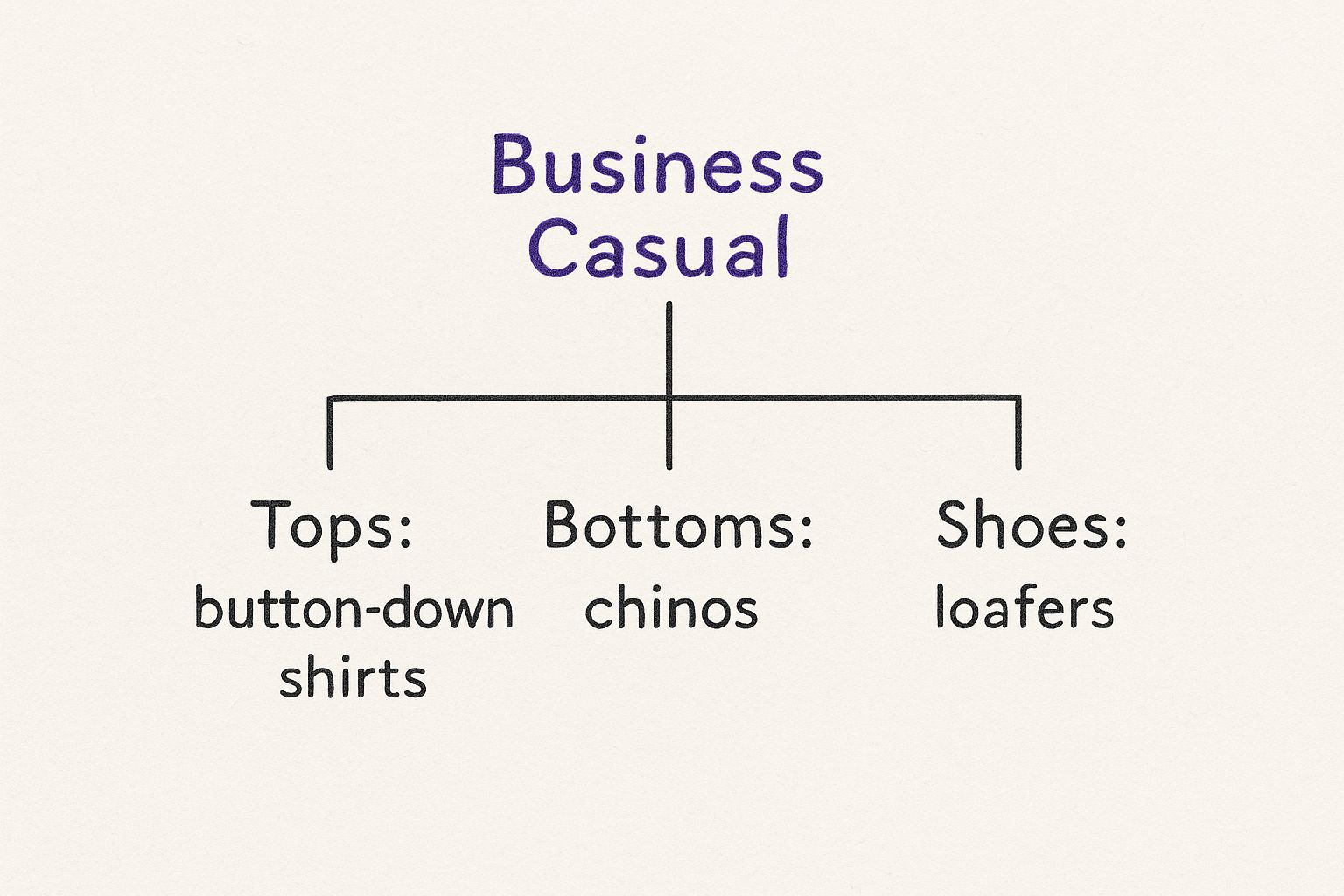
As you can see, button-downs, chinos, and loafers are the undisputed foundation of any solid business casual wardrobe.
For a clearer picture of where business casual fits in, this quick table breaks down the key differences between the major dress codes.
Business Casual Spectrum At a Glance
| Attire Category | Formal Business | Business Casual | Casual |
|---|---|---|---|
| Tops | Suit jacket, dress shirt, tie | Sport coat, blazer, dress shirt, polo | T-shirt, flannel, hoodie |
| Bottoms | Matching suit trousers | Chinos, dress slacks, dark denim | Jeans, shorts, joggers |
| Footwear | Oxfords, Derbys | Loafers, Chelsea boots, dress sneakers | Sneakers, sandals |
| Overall Vibe | Authoritative, traditional | Polished, approachable, modern | Relaxed, personal, informal |
This comparison really highlights how business casual offers the most versatility, borrowing elements from both the formal and casual ends of the spectrum.
The New Professional Norm
The move toward this style is more than just a feeling—the numbers back it up. A recent Gallup poll showed that 41% of American workers now wear business casual to the office. Meanwhile, the traditional suit has hit an all-time low, worn by just 3% of professionals.
This isn't just a trend; it's a fundamental shift. Getting a handle on business casual is no longer just a good idea—it's pretty much essential for navigating the modern workplace.
Business casual is really about showing respect for your workplace, your colleagues, and yourself through thoughtful choices. It's less about a rigid checklist and more about building a polished, professional image that still feels like you.
Remember, dressing well is a form of communication that goes beyond the office walls. To keep your professional brand consistent, it’s also a smart move to optimize your LinkedIn profile for a professional look. Once you master this dress code, that morning guesswork transforms into effortless confidence.
Building Your Business Casual Foundation
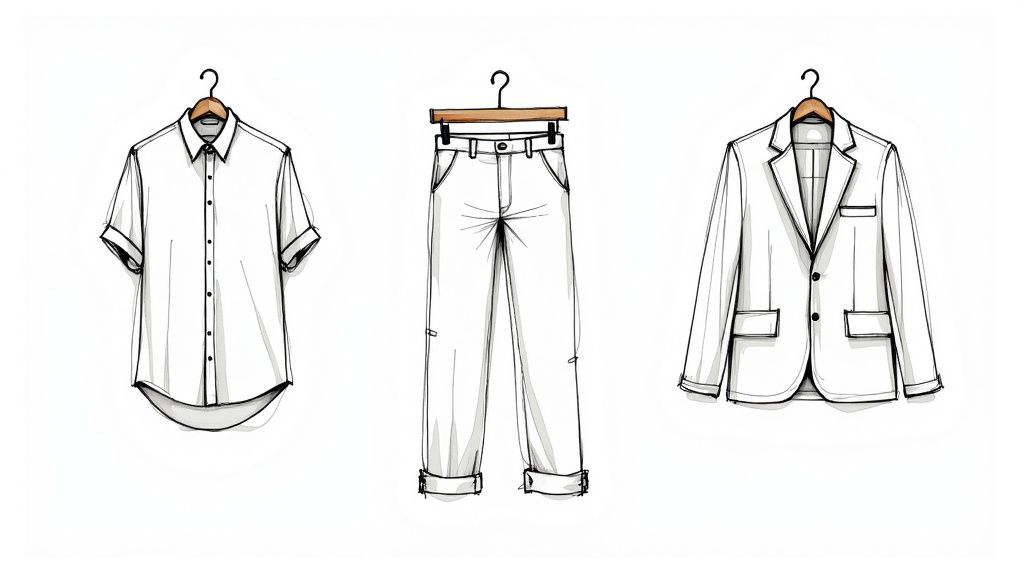
A great business casual wardrobe isn't about having a closet overflowing with clothes. It's about owning the right pieces—versatile, high-quality staples that you can build countless sharp outfits around. Think of it as a style toolkit, where each item has a purpose and works with the others to create something impressive.
This approach will save you time, money, and that all-too-familiar morning headache of figuring out what to wear. When you focus on a core collection of essential shirts, trousers, and shoes, you’re creating a system where almost everything pairs together effortlessly. The goal here is simple: invest in quality over quantity and make sure every piece elevates your professional look.
The Essential Shirts
The right shirt is the centerpiece of any business casual look. It really sets the tone for everything else, so it's the perfect place to start. You only need a few key styles to have all your bases covered for just about any work scenario.
Your first, and most important, investment should be the Oxford Cloth Button-Down (OCBD). It’s the undisputed champion of business casual, and for good reason. Its textured cotton weave is tough but breathable, which makes it perfect for wearing all year round. Start with the classics like white and light blue before you branch out to other shades.
From there, think about adding a couple of other options to your rotation:
- The Chambray Shirt: People often mistake it for denim, but chambray is much lighter and softer. It gives off a slightly more relaxed vibe than an Oxford but still looks sharp enough for most offices, especially on a Friday.
- The Dress Shirt: A crisp dress shirt made from smooth cotton poplin or twill is a definite step up in formality. Keep one in white or a subtle pattern for those days when you need to lean more into the "business" side of the dress code, like for a big meeting.
By mastering these three shirt styles, you're building a versatile core that can be dressed up with a blazer or worn on its own. It's a simple, effective strategy for always looking put-together without overthinking it.
Versatile Trousers
Once you have your shirts sorted, it's time to find the right trousers. This is where a lot of guys stumble, but getting it right is actually pretty straightforward. It all comes down to focusing on fit and fabric.
Chinos are the absolute cornerstone of a business casual wardrobe. They’re dressier than jeans but way more comfortable and relaxed than traditional suit trousers. If you stick to timeless, neutral colors like khaki, navy, and grey, you'll be able to wear them with almost anything. A slim or straight fit—nothing too tight or too baggy—is universally flattering and professional.
For a slightly more polished alternative, a pair of well-tailored wool or cotton-blend dress pants is an excellent addition. These are perfect for pairing with a blazer or sport coat when you need a more elevated look. They create a sharper silhouette than chinos and are ideal for more conservative office environments or client-facing roles.
Foundational Footwear
Your shoes anchor your entire outfit. The wrong pair can instantly drag down a sharp look, while the right ones pull everything together perfectly. You really only need three styles to build a complete and versatile foundation for any business casual dress code.
1. The Loafer: Whether they're penny loafers or horsebit loafers, a pair in brown or black leather is incredibly adaptable. They look just as good with chinos as they do with dress trousers, giving off a sophisticated but effortless vibe.
2. The Derby: A bit more relaxed than a formal Oxford, the Derby shoe is a business casual workhorse. Its open-lacing system gives it a slightly less stuffy feel, making it a perfect match for the modern office.
3. The Minimalist Leather Sneaker: In recent years, clean leather sneakers have rightfully earned their spot in the workplace. Just be sure to choose a simple, unbranded style in white or black. This is your go-to for casual Fridays or offices with a more laid-back culture.
The definition of business casual can be a real challenge, particularly for younger professionals who joined the workforce after the pandemic shifted everything toward casual wear. In fact, surveys show just 3% of men now wear a suit to work regularly. What's considered acceptable, like wearing jeans, varies wildly by industry, which just underscores the importance of having versatile footwear that can adapt.
By investing in these foundational pieces, you're not just buying clothes; you're building a reliable system for professional style. Choosing the right colors is also key to making sure every piece you buy works for you—you can learn how to find your color palette to get it just right.
Elevating Your Look with Layers and Outerwear
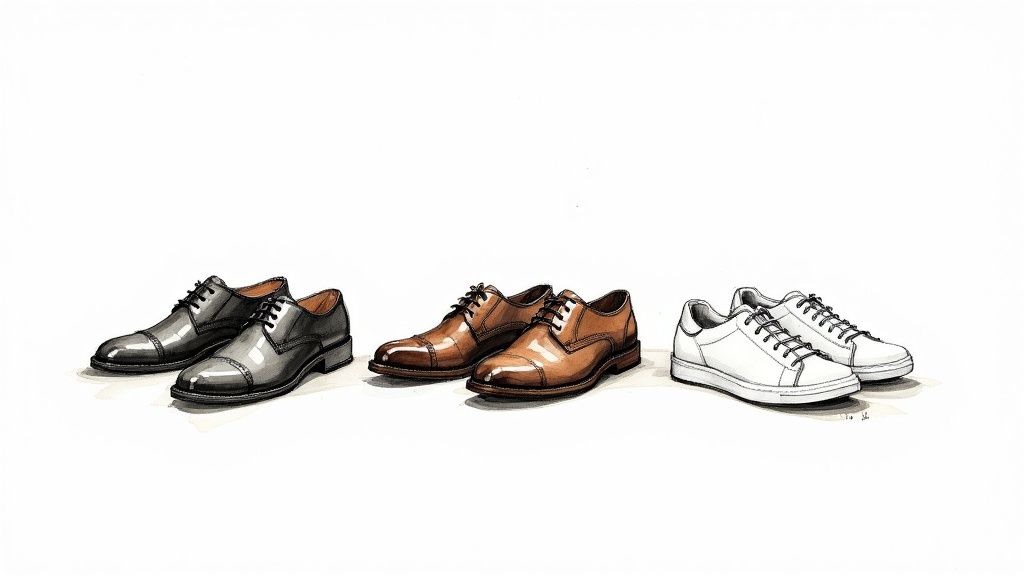
Alright, you've got the foundational pieces down. Now it's time to add the polish and personality that really make a business casual look click. Think of layering as your secret weapon—it's how you add depth, texture, and adaptability to your outfit.
The right layers let you instantly adjust your level of formality and stay comfortable, whether you're dealing with a chilly morning commute or a stuffy conference room. Mastering this skill is what transforms a simple shirt-and-pants combo into a thoughtful, complete look. It shows you put some real thought into your appearance, moving you from just being "dressed for work" to being "well-dressed."
The Power of the Blazer and Sport Coat
Nothing levels up a business casual outfit faster than a great blazer or sport coat. People often use the terms interchangeably, but they have subtle differences. The real takeaway is that they both add instant structure and a touch of authority to your look.
A blazer is the more traditional of the two. It's typically a solid-colored jacket—navy is the classic—with a more structured build and sometimes metal buttons. It’s an incredibly reliable piece that pairs effortlessly with everything from grey wool trousers to crisp khaki chinos.
A sport coat is its slightly more relaxed cousin. Originally designed for, well, sporting activities, these jackets come in a much wider variety of patterns (like checks or houndstooth) and fabrics (think tweed or corduroy). They're a fantastic way to inject some visual interest and texture into your wardrobe.
Think of a blazer or sport coat as the frame for your outfit. It pulls everything together, creating a clean, professional silhouette that commands respect. Throwing one over a button-down shirt is the fastest way to dial up the "business" in business casual.
This one move is crucial for making a strong impression, especially in meetings or presentations. It perfectly bridges the gap between a simple shirt-and-trousers outfit and a full suit, hitting that business casual sweet spot.
Embracing Versatile Knitwear
Knitwear is the unsung hero of the layered business casual wardrobe. It offers both warmth and a refined sense of comfort, providing a softer alternative to the structure of a blazer and making it perfect for everyday office wear. The trick is to stick with classic styles in high-quality materials like merino wool or cashmere.
Consider adding these essentials to your rotation:
- The Crewneck Sweater: Worn over a collared shirt, a slim-fit crewneck in a neutral color like charcoal, navy, or burgundy is a timeless, can't-miss choice. It adds a layer of warmth and a pop of color without being bulky.
- The V-Neck Sweater: Very similar to the crewneck, the V-neck is specifically designed to frame the collar of your shirt and even a tie knot. It’s a classic look that works especially well in more traditional office settings.
- The Cardigan: A button-up cardigan gives you incredible versatility. You can wear it open for a more relaxed vibe or buttoned up for a neater, more pulled-together appearance.
These pieces allow you to fine-tune your comfort and formality all day long. A cardigan can be easily taken off and draped over your chair, while a fine-gauge sweater fits smoothly under a sport coat on colder days. It’s all about having options.
This demand for adaptable clothing is a huge driver in the market. The global men's wear market hit roughly USD 590 billion in 2023 and is projected to climb to nearly USD 924 billion by 2030. That growth comes from men investing in quality, flexible pieces like relaxed blazers and smart knitwear. You can find more details in this report covering the men's apparel market trends on grandviewresearch.com.
By understanding how to combine these different layers, you create a dynamic wardrobe that's ready for anything. You can start the day with a sweater and blazer, shed the blazer at your desk, and still look perfectly polished.
Mastering the Details: Fit, Color, and Fabric
The real secret to looking sharp isn't about the price tag. It’s about the details. What separates a decent outfit from a truly great one comes down to three things: fit, color, and fabric.
Nailing these three pillars is what elevates a standard business casual look into something that feels custom, confident, and put-together. It’s how you communicate competence and an eye for detail before you even shake a hand.
Getting the Perfect Fit
Let's start with the foundation of your entire wardrobe: the fit. A perfectly fitting garment flatters your body and moves with you. On the flip side, an ill-fitting piece, no matter how expensive, just looks sloppy.
The goal is a clean, tailored silhouette that’s neither too tight nor too baggy. Don't worry, it's less complicated than it sounds. You just need to know a few key checkpoints.
For Shirts:
- Shoulder Seams: Check where the seam hits. It should sit right on the edge of your shoulder bone. If it’s drooping down your arm, the shirt's too big. If it's creeping up toward your neck, it's too small.
- Torso: You should be able to pinch about 1-2 inches of fabric on either side of your stomach. Any more, and it looks billowy; any less, and you're straining the buttons.
- Sleeve Length: Cuffs should end right at the base of your wrist. This is especially important with a blazer, as it allows about a half-inch of your shirt cuff to peek out—a classic sartorial touch.
For Trousers:
- Waist: Simple test: your trousers should stay up comfortably without a belt. If you need a belt to hold them up, they're too big.
- Seat: The fabric should drape smoothly across your backside. If you see horizontal wrinkles pulling, they're too tight. If it's sagging, they’re too loose.
- Length (The Break): The "break" is that small fold of fabric where your trousers meet your shoes. For modern business casual, aim for a slight break or even no break at all. It creates a much cleaner, sharper line.
Building Your Color Palette
Color is your best tool for setting a mood and creating a cohesive wardrobe. While you should always wear what makes you feel good, building a business casual palette on a foundation of versatile neutrals is a game-changer. It makes getting dressed in the morning practically effortless.
Start with a core group of neutral workhorses. Think of colors like navy, charcoal grey, and khaki as your primary building blocks.
Your core colors are the foundation, while your accent colors are the personality. Mastering this balance is key to creating a wardrobe that is both versatile and expressive, ensuring you always have something smart to wear.
Once your base is set, you can start bringing in secondary colors and subtle accents. A quick tip: learning the best neutral colors for your skin tone can make an incredible difference in how sharp and healthy you look.
Essential Business Casual Color Palette
This table is a simple guide to building a versatile wardrobe. Start with the base colors and then thoughtfully add accents to bring your outfits to life.
| Color Category | Primary Colors | Secondary/Accent Colors |
|---|---|---|
| Base Colors | Navy, Charcoal Grey, Khaki, White | Light Blue, Olive Green, Burgundy |
| Why It Works | These colors are timeless, professional, and pair well with virtually everything. | These add depth and personality without being overly loud or distracting. |
By sticking to this framework, you’ll find that almost everything in your closet works together, making it easy to create polished looks on the fly.
Understanding Fabric Choices
Fabric is about more than just feel—it communicates formality and intent. A breezy linen shirt, for example, sends a much more relaxed signal than a pair of crisp wool trousers.
For business casual, stick with natural fibers that breathe well and hold their shape. Cotton is the undisputed king for shirts, especially in classic weaves like Oxford or poplin. For trousers, cotton chinos are a must-have staple. When you need something a bit more refined, especially in cooler weather, wool offers a fantastic drape and structure.
And remember, a sharp look is a complete package. Polished grooming is just as important as the clothes you wear. For a classic, put-together hairstyle, look into mastering your style with American Crew Pomade to complete the look.
Practical Outfit Ideas for Any Work Scenario
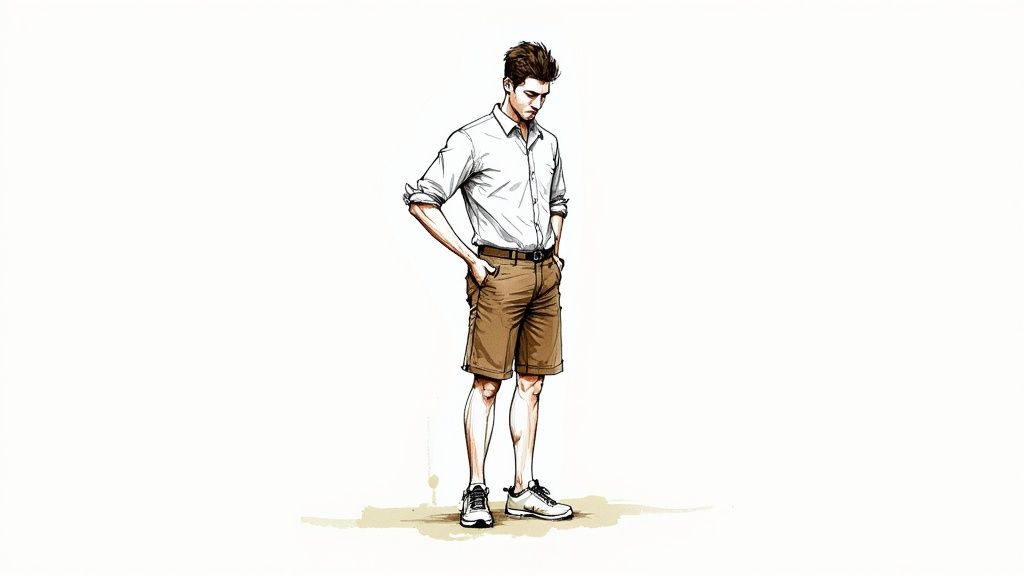
Knowing the individual pieces is one thing, but seeing how they all click together is where real confidence comes from. So, let's move from theory to practice with some solid outfit formulas you can lean on for just about any professional situation.
Think of these as reliable blueprints. You can always swap out colors or make small tweaks to fit your personal style, but the core structure of each look is a proven winner. This is your personal lookbook for walking into any work scenario with style and ease.
The Everyday Office Standard
This is your workhorse outfit, the go-to for a typical day at the office. We're talking internal meetings, focused desk work, and team projects. The goal is simple: look professional and approachable, but stay comfortable. This look nails that balance perfectly.
- Top: An Oxford Cloth Button-Down (OCBD) shirt is the undisputed champ here. Go for a versatile color like light blue or white. Its slightly textured fabric keeps it from feeling too stuffy or formal.
- Bottoms: You can't go wrong with classic khaki or navy chinos. Just make sure they have a modern slim or straight fit—nothing too tight or too baggy—to keep the silhouette clean.
- Footwear: A pair of brown leather penny loafers or some suede derbies will ground the outfit with a touch of class. They’re way sharper than sneakers but still comfortable enough to wear all day.
There's a reason this combination is a classic. Every piece is timeless and they all work together seamlessly, projecting an image of quiet, reliable competence. It’s a clean, no-fuss look that simply says you're ready to get to work.
The Key Client Presentation
When the stakes are higher, your outfit needs to do some of the talking for you. It should communicate authority, seriousness, and a sharp attention to detail. This is where you dial up the formality to show your client you take them—and their business—seriously.
For high-stakes professional moments, your attire is the opening statement. A well-chosen sport coat and polished trousers don't just complete an outfit; they build a visual foundation of credibility and respect before you even say a word.
This look is all about projecting polish and confidence.
The Polished Presenter Breakdown:
- The Layer: A navy or charcoal sport coat is non-negotiable. A quality wool jacket adds structure to your shoulders and creates a powerful silhouette that just radiates confidence.
- The Shirt: Ditch the OCBD for a crisp, smooth dress shirt. A clean white or a subtle pattern, like a fine pinstripe, signals a higher level of formality.
- The Trousers: Level up your lower half with well-tailored wool trousers in a complementary color like medium grey. The way wool drapes is just far superior to cotton chinos in this context.
- The Shoes: Finish the look with a pair of polished dark brown or black leather derbies or monk straps. And it should go without saying, make sure they are spotless.
This entire outfit is designed to command respect. It shows you understand the gravity of the meeting and have dressed for the occasion, building trust before the handshake even happens.
The Smart Casual Friday
Ah, Casual Friday. It can be a real minefield. You want to relax your look, but you can't afford to look sloppy or like you've already checked out for the weekend. This outfit perfectly navigates that tricky balance by combining comfortable staples with the clean lines of business attire.
The whole trick is to take traditionally casual items and elevate them.
- Top & Layer: Start with a high-quality plain t-shirt or a fine-gauge knit sweater. Then, throw an unstructured blazer over it. A cotton or linen-blend jacket gives you a sharp silhouette that’s still relaxed and comfortable.
- Bottoms: This is the perfect time to break out a pair of dark-wash denim jeans. The key here is that they must be a slim fit, a solid dark color, and have absolutely no rips or distressing.
- Footwear: A pair of clean, minimalist leather sneakers in white or black is the ideal finishing touch. They keep the outfit modern and comfortable while still looking intentional and put-together.
This look proves you can adapt to a more laid-back environment without ever dropping your standards. It's stylish, comfortable, and the perfect way to wrap up the work week.
Common Business Casual Mistakes to Avoid
Trying to nail the business casual dress code can feel like walking a tightrope. Lean too far one way, and you look stiff and overdressed. Go too far in the other direction, and you risk looking sloppy or like you didn't put in any effort. Honestly, knowing what not to do is half the battle.
Steering clear of these common pitfalls will keep your professional image sharp and on point. It’s usually the small things—the details you might not even notice—that can completely tank an otherwise solid outfit and send the wrong message.
Forgetting That Fit Is Everything
If there’s one mistake that tops the list, it's ignoring fit. I’ve seen it a hundred times: a guy in a high-end shirt that’s billowing around his waist, or trousers so tight they look like they’re painted on. An affordable, well-fitting outfit will always look a million times better than an expensive one that doesn't fit you properly. It's just a fact.
Think of fit as the foundation of your entire look. If that foundation is off, everything you layer on top of it will crumble. This goes for every single piece, from where the seams of your shirt hit your shoulders to how your trousers fall over your shoes.
A perfect fit does more than just flatter your body; it communicates that you are deliberate and detail-oriented. It's the silent language of competence that speaks volumes before you even say a word.
Wearing the Wrong Shoes
Your shoes ground your entire outfit, so getting them wrong is a classic blunder. Let's be clear: your gym sneakers, beat-up boat shoes, and heavy hiking boots have absolutely no place in a business casual setting. They’re built for a specific purpose, and that purpose isn't the office.
On the flip side, super formal shoes like shiny patent leather Oxfords can feel out of sync, too. The real key is finding that happy medium with shoes that can easily bridge the gap between dressed-up and relaxed.
- Mistake: Worn-out, athletic running shoes.
- Alternative: A pair of clean, minimalist leather sneakers in a simple white or black.
- Mistake: Scuffed, clunky square-toed dress shoes.
- Alternative: Timeless leather loafers or some sharp suede derby shoes.
Overlooking Garment Care
You can put together the perfect combination of clothes, but if your shirt is a wrinkled mess or your chinos have a coffee stain from yesterday, the whole look is ruined. Wrinkles instantly signal a lack of care and make it seem like you just grabbed whatever was on the floor. Proper garment care isn’t just a suggestion; it’s a non-negotiable part of dressing well.
This isn’t just about ironing, either. We’re talking about faded colors, sweaters with little pills all over them, and scuffed-up shoes. Maintaining your wardrobe is just as important as choosing the right pieces in the first place. It’s what ensures you look polished and intentional every time you walk out the door.
Answering Your Business Casual Questions
Let's face it, navigating the gray areas of business casual can be a headache. The rules seem to shift from one office to the next, leaving a lot of guys wondering what actually works. It's time to clear up some of the most common points of confusion.
Of course, even with the best guidelines, your personal style is the secret ingredient. What looks fantastic on one person might not hit the same way on another, and a lot of that comes down to the subtle interplay between fabric colors and your own natural coloring. Knowing which shades make you look your best is a game-changer. You can figure this out with a simple what is my color season quiz.
Can You Wear Jeans?
Yes, but this is a big "it depends." If you're going to wear jeans, they have to be the right kind: dark-wash, no rips or fading, and a clean, tailored fit. In a more laid-back creative or tech office, a sharp pair of dark jeans with a blazer is a go-to look. But if you’re in a more buttoned-up field like finance or law, it's always smarter to stick with chinos or proper trousers.
Are Sneakers Appropriate?
They can be, but you have to be very selective. We're talking about sleek, minimalist leather sneakers in a neutral color like white or black—the kind with no flashy logos. Your beat-up gym trainers or chunky basketball shoes are a definite no. The whole point is to look polished and put-together, not like you just came from a workout.
When in doubt, always err on the side of being slightly more dressed up. It’s far better to be the best-dressed person in the room than the most casual.
Take your style to the next level with a professional analysis
You already know the theory. Now discover exactly which colors and styles enhance your personal image.
Loading...
Complete PDF report in less than 5 minutes
Your color season and personalized palette
Specific makeup and clothing recommendations
Based on professional color analysis
One-time investment:
One-time payment, no subscriptions. Instant access.